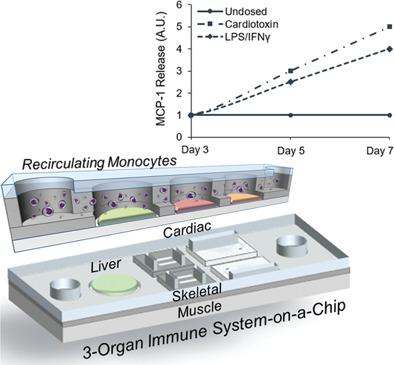Our official English website, www.x-mol.net, welcomes your feedback! (Note: you will need to create a separate account there.)
Differential Monocyte Actuation in a Three-Organ Functional Innate Immune System-on-a-Chip.
Advanced Science ( IF 15.1 ) Pub Date : 2020-06-02 , DOI: 10.1002/advs.202000323 Trevor Sasserath 1 , John W Rumsey 1 , Christopher W McAleer 1 , Lee Richard Bridges 1 , Christopher J Long 1 , Daniel Elbrecht 1 , Franz Schuler 2 , Adrian Roth 2 , Christina Bertinetti-LaPatki 2 , Michael L Shuler 1 , James J Hickman 1, 3
Advanced Science ( IF 15.1 ) Pub Date : 2020-06-02 , DOI: 10.1002/advs.202000323 Trevor Sasserath 1 , John W Rumsey 1 , Christopher W McAleer 1 , Lee Richard Bridges 1 , Christopher J Long 1 , Daniel Elbrecht 1 , Franz Schuler 2 , Adrian Roth 2 , Christina Bertinetti-LaPatki 2 , Michael L Shuler 1 , James J Hickman 1, 3
Affiliation

|
A functional, human, multiorgan, pumpless, immune system‐on‐a‐chip featuring recirculating THP‐1 immune cells with cardiomyocytes, skeletal muscle, and liver in separate compartments in a serum‐free medium is developed. This in vitro platform can emulate both a targeted immune response to tissue‐specific damage, and holistic proinflammatory immune response to proinflammatory compound exposure. The targeted response features fluorescently labeled THP‐1 monocytes selectively infiltrating into an amiodarone‐damaged cardiac module and changes in contractile force measurements without immune‐activated damage to the other organ modules. In contrast to the targeted immune response, general proinflammatory treatment of immune human‐on‐a‐chip systems with lipopolysaccharide (LPS) and interferon‐γ (IFN‐γ ) causes nonselective damage to cells in all three‐organ compartments. Biomarker analysis indicates upregulation of the proinflammation cytokines TNF‐α , IL‐6, IL‐10, MIP‐1, MCP‐1, and RANTES in response to LPS + IFN‐γ treatment indicative of the M1 macrophage phenotype, whereas amiodarone treatment only leads to an increase in the restorative cytokine IL‐6 which is a marker for the M2 phenotype. This system can be used as an alternative to humanized animal models to determine direct immunological effects of biological therapeutics including monoclonal antibodies, vaccines, and gene therapies, and the indirect effects caused by cytokine release from target tissues in response to a drug's pharmacokinetics (PK)/pharmacodynamics (PD) profile.
中文翻译:

三器官功能先天免疫芯片系统中的差异单核细胞激活。
开发了一种功能性、人体、多器官、无泵、芯片上的免疫系统,其特点是在无血清培养基中的不同隔室中循环 THP-1 免疫细胞、心肌细胞、骨骼肌和肝脏。该体外平台可以模拟对组织特异性损伤的靶向免疫反应,以及对促炎化合物暴露的整体促炎免疫反应。靶向反应的特点是荧光标记的 THP-1 单核细胞选择性地渗透到胺碘酮受损的心脏模块中,并改变收缩力测量值,而不会对其他器官模块造成免疫激活损伤。与靶向免疫反应相反,使用脂多糖(LPS)和干扰素-γ(IFN- γ )对免疫人体芯片系统进行一般促炎治疗会对所有三器官区室中的细胞造成非选择性损伤。生物标志物分析表明,促炎细胞因子 TNF- α、IL-6、IL-10、MIP-1、MCP-1 和 RANTES 响应 LPS + IFN- γ治疗而上调,表明 M1 巨噬细胞表型,而仅胺碘酮治疗导致恢复性细胞因子 IL-6 的增加,这是 M2 表型的标志。该系统可用作人源化动物模型的替代方案,以确定生物疗法(包括单克隆抗体、疫苗和基因疗法)的直接免疫效应,以及靶组织释放细胞因子响应药物药代动力学(PK)引起的间接效应/药效学 (PD) 概况。
更新日期:2020-07-08
中文翻译:

三器官功能先天免疫芯片系统中的差异单核细胞激活。
开发了一种功能性、人体、多器官、无泵、芯片上的免疫系统,其特点是在无血清培养基中的不同隔室中循环 THP-1 免疫细胞、心肌细胞、骨骼肌和肝脏。该体外平台可以模拟对组织特异性损伤的靶向免疫反应,以及对促炎化合物暴露的整体促炎免疫反应。靶向反应的特点是荧光标记的 THP-1 单核细胞选择性地渗透到胺碘酮受损的心脏模块中,并改变收缩力测量值,而不会对其他器官模块造成免疫激活损伤。与靶向免疫反应相反,使用脂多糖(LPS)和干扰素-γ(IFN- γ )对免疫人体芯片系统进行一般促炎治疗会对所有三器官区室中的细胞造成非选择性损伤。生物标志物分析表明,促炎细胞因子 TNF- α、IL-6、IL-10、MIP-1、MCP-1 和 RANTES 响应 LPS + IFN- γ治疗而上调,表明 M1 巨噬细胞表型,而仅胺碘酮治疗导致恢复性细胞因子 IL-6 的增加,这是 M2 表型的标志。该系统可用作人源化动物模型的替代方案,以确定生物疗法(包括单克隆抗体、疫苗和基因疗法)的直接免疫效应,以及靶组织释放细胞因子响应药物药代动力学(PK)引起的间接效应/药效学 (PD) 概况。

























 京公网安备 11010802027423号
京公网安备 11010802027423号